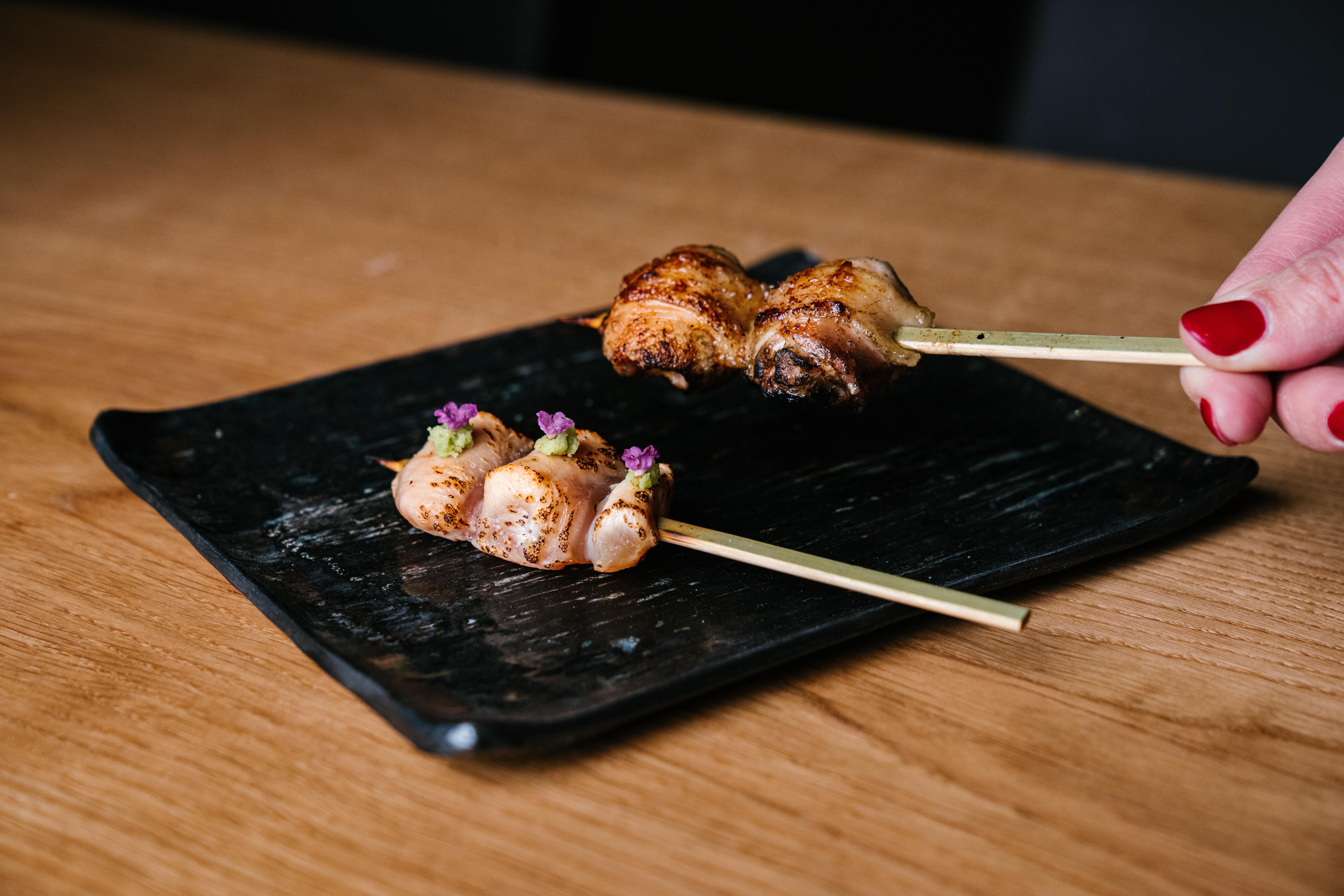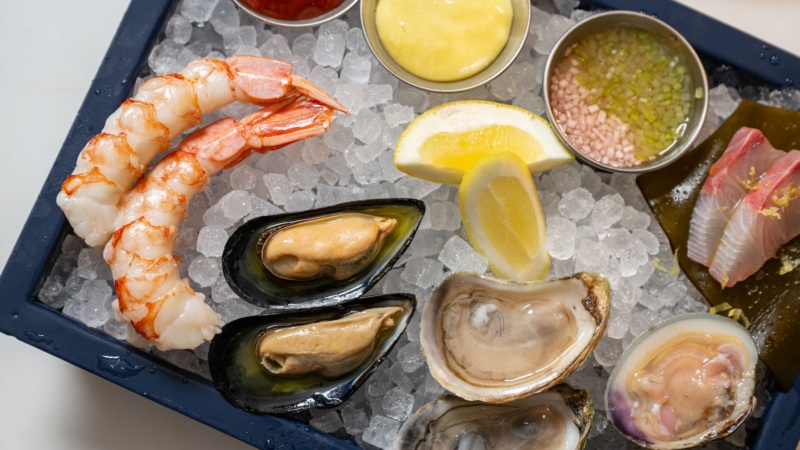
Everything You Need to Know About New York’s Latest Omakase Restaurant, Kono
Before you go to a restaurant, what do you want — or need — to know most? In our series, The Rundown, we’re sharing all the essentials about newly opened (as well as some of your favorite) restaurants.
This time, we’re taking a look at Kono, the new yakitori omakase spot from chef Atsushi “ATS” Kono, set to open on April 25. Tucked inside Canal Arcade, a dim passageway that links the Bowery and Elizabeth streets, the kappo-style restaurant allows Kono to take center stage, showcasing the skills he has accumulated after working for more than two decades in the restaurant industry, both in Japan and New York. Traditionally, kappo cuisine aims to create balance with elements throughout the meal, while showcasing various cooking techniques, such as simmering and frying.
Kono’s 16-course omakase ($165 per person) — which includes a yakitori progression of 10 to 12 skewers — draws from his time at Kyoryori Suzuyoshi, a kappo-style restaurant located in Tokyo, and merges it with the yakitori expertise he picked up as the executive chef and general manager of Yakitori Torishin, the Michelin-starred Hell’s Kitchen restaurant specializing in Japanese grilled skewers. His namesake restaurant offers a taste of both Kono’s exceptional yakitori and innovative small dishes via an intimate dining experience. Here’s everything you need to know about it.
1. Kono got its start as a pandemic pop-up.
After leaving Torishin in 2019, Kono joined Chikarashi Isso as its chef de cuisine, returning to his roots in kappo cuisine. But less than four months after the highly anticipated Financial District restaurant opened, it temporarily shuttered due to the COVID-19 pandemic. As outdoor dining quickly became the only alternative, Kono knew it was time to pivot. “We were closed, and I thought, ‘Maybe we can barbecue outside since the city started outdoor seating’,” he recalls. That fall, Chikarashi Isso reopened, but in a different location with an entirely different menu: a 13-course kappo-style yakitori omakase served on the terrace of Hotel 50 Bowery, a property owned by Kono’s business partners. It became an incubator of sorts for the chef, who seized it as an opportunity to start honing his future restaurant concept. “That was my very first step of this project. I focused 100% of my skill, experience, and energy on it. It was a great experience and most of that team will be the same team at Kono.”


2. It took Kono three years — and many trips to Pennsylvania — to find the right chickens for his yakitori.
The Chikarashi Isso pop-up ran for 10 months before the restaurant returned to its original space, but the opportunity showed Kono and his partners that New Yorkers had, well, an appetite for a kappo-style yakitori omakase. This trial run allowed Kono to test dishes — diners who went to his pop-up may recognize some of the menu items here — and to seek out the best chickens for them. He made multiple trips to Pennsylvania’s Amish Country in search of birds that had the right flavor and texture for his needs. “I went to farms and met with poultry workers. It took three years and I tried many, many chickens,” says Kono, who ultimately settled on three types: an organic free-range bird, one that’s fed a strict vegetarian diet, and the Sasso chicken, a fatty, rich variety similar to those in Japan. “I developed relationships with farmers and poultry workers,” he says. Often, “they cut the chickens, take out the organs, and sometimes throw them out. But those organs are special.”


3. While Kono’s yakitori style is traditional, he’s also keeping seasonality in mind.
Instead of being wasted, the organs are now being sent to Kono, where parts like gizzards, livers, and tails are grilled over binchotan hardwood charcoal. Though his yakitori is rooted in tradition, Kono brings in seasonal vegetables as a complement to the chicken. ”I’m using different types of vegetables, not only Japanese ones,” he explains. “For example, right now, we can get black morel mushrooms, ramps, and bamboo shoots from Oregon. We can get such fresh ingredients, I wanted to use them in my omakase.”
The appetizers that lead off Kono’s menu lean into the kappo style of cooking, which focuses on both seasonality and balance. “I’m always aware of the flow, flavor combinations, and texture. Omakase starts with light flavors and so my concept is always pure [at the beginning]. I use Japanese umami five flavors — sweet, salt, sour, bitter, and spicy — to help with the flow, along with temperature control. Sometimes [the food is] very cold, sometimes warm, and sometimes very hot.”


4. The design of the dining room was inspired by Japanese kabuki.
Nestled discreetly away from bustling Bowery, the restaurant’s location reminds Kono of the underground restaurants that are found in Tokyo’s subway stations. “I love the Arcade location. It’s like a secret spot,” he says. It’s also one that’s been getting renewed attention over the last few years with the arrival of soup dumpling restaurant Joe’s Shanghai and more recently, edomae sushi counter Nakaji.
Inside, the design nods to another Japanese tradition: kabuki theater. The 14-seat chef’s counter, crafted from white oak wood, resembles a square stage with a kitchen located in the middle. Lighting will be dim around the exterior, with bright spotlights shining down on Kono’s three stations, creating a show-like experience. There’s also a semi-private dining area that can seat four to six. “That section is one step higher, so you can still see the chef. It’s the same experience as the counter.”


5. The drinks menu includes a savory martini.
General manager Louis Andia, a member of the Chikarashi Isso team, was tapped to pull together the beverage program at Kono. It leans toward Japanese flavors and influences, with playful cocktails like a martini infused with tare, the savory yakitori sauce. There’ll be a premium Suntory malt on draft, a handful of craft beers sourced from a variety of prefectures, as well as sake, shochu, and white wine. Because one of Kono’s business partners is a Japanese whisky collector, diners will also get a chance to sample rare vintages. And, of course, no yakitori menu would be complete without a highball, the Japanese drink that’s part whisky, part sparkling water. Here, the team is sticking to the classic variation — as Kono says, “Highballs and yakitori are the best combination.”
Kono is open Monday through Saturday with seatings at 5:30 p.m., 6 p.m., 8:30 p.m. and 9 p.m.
Patty Lee is a New York-based writer and editor who has contributed to Thrillist, Time Out New York, and more. Follow her on Instagram and Twitter. Follow Resy, too.




























